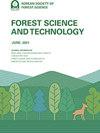Land cover changes and carbon storage before and after community forestry program in Bleberan village, Gunungkidul, Indonesia, 1999–2018
IF 2.2
Q2 FORESTRY
引用次数: 10
Abstract
Abstract This study investigated the land cover changes, carbon storage dynamics and their underlying socio-economic processes before and after a community forest permit in Bleberan village, Gunungkidul, Indonesia, during 1999–2018. We used a combination of the forest canopy density model, carbon conversion and socio-economic related data to analyze land cover classes in the periods of 1999–2003, 2003–2009, and 2009–2018, representing the phases of several years before community forestry permit, initial phase of community forestry establishment and several years after community forestry permit, respectively. Results showed that at baseline (1999), where illegal logging was started on the ground, the condition of the 40 ha investigated area was dominated by non-forest in the form of open land by 54% with an amounted carbon storage of 1352.62 ton. In the phase of before community forestry permit (1999–2003), when there was continuous illegal logging, the open land rise quickly achieved to 83%, with only 312.09 ton of carbon storage remaining. In the initial phase of community forestry establishment (2003–2009), when the government issued a legalization of community forest, the mixed dryland agriculture shifted to dominate the area by 55%, with the carbon storage being increased to 1840.94 ton. The last phase, several years after community forestry permit (2009–2018), which characterized by active engagement of the community in forest rehabilitation, the area was altered to fully stocked teak plantation forest by 82%, with a carbon storage enhancement of 3379.16 ton or two times higher than that at baseline. Such results are important for the forest community authority and related stakeholder for designing appropriate forest-related policies and supporting REDD + implementation.1999-2018年印度尼西亚Gunungkidul Bleberan村社区林业项目前后的土地覆盖变化和碳储量
摘要:本研究调查了1999-2018年印度尼西亚Gunungkidul Bleberan村社区森林许可前后的土地覆盖变化、碳储量动态及其潜在的社会经济过程。我们结合森林冠层密度模型、碳转换和社会经济相关数据,分析了1999-2003年、2003-2009年和2009-2018年期间的土地覆盖类别,分别代表了社区林业许可前几年、社区林业建立初期和社区林业许可后几年的阶段。结果表明:在基线(1999年)开始进行地面非法采伐时,40 ha调查区以开阔地形式的非森林为主,占54%,碳储量达1352.62 t;在社区林业许可证发放前阶段(1999-2003年),非法采伐现象不断,开阔地上升迅速达到83%,碳储量仅剩312.09吨。在社区林业建设初期(2003-2009年),政府颁布了社区林业合法化令,混合旱地农业转变为55%,碳储量增加到1840.94吨。最后一个阶段,在获得社区林业许可的几年后(2009-2018年),以社区积极参与森林恢复为特征,该地区被改变为82%的充足柚木人工林,碳储量增加了3379.16吨,比基线增加了两倍。这些结果对于森林社区当局和相关利益攸关方设计适当的森林相关政策和支持REDD +实施具有重要意义。
本文章由计算机程序翻译,如有差异,请以英文原文为准。
求助全文
约1分钟内获得全文
求助全文

 求助内容:
求助内容: 应助结果提醒方式:
应助结果提醒方式:


